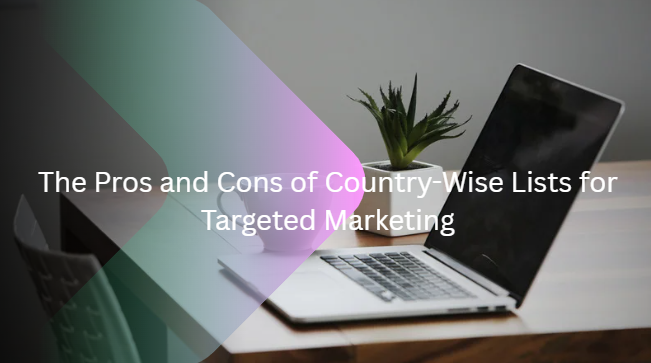Advantages of Using Country-Wise Lists in Campaigns
The Pros and Cons of Country-Wise Lists lean favorably toward their many advantages in crafting personalized and relevant marketing efforts. One of the most significant benefits is enhanced personalization. With country-specific data, marketers can create tailored content that resonates with local customs, language preferences, and purchasing behaviors, increasing country wise email marketing list engagement and conversion rates. Additionally, these lists facilitate better compliance with regional data protection laws like the GDPR in Europe or CAN-SPAM in the United States, as marketers can apply country-specific opt-in and consent practices. Geographic segmentation also allows businesses to optimize send times by accounting for local time zones, improving the chances that messages are seen and acted upon. Moreover, this targeted approach can reduce unsubscribe rates by minimizing irrelevant or poorly timed communications. These advantages collectively contribute to more effective, customer-centric campaigns that can drive loyalty and revenue growth.

Challenges and Limitations of Country-Wise Lists
Despite their clear benefits, The Pros and Cons of Country-Wise Lists also encompass significant challenges that marketers must navigate. Data accuracy is a persistent issue; maintaining up-to-date and precise location information requires constant validation since subscribers may move or use VPNs that mask their actual location. Compliance complexities multiply as marketers must keep abreast of varying laws and regulations in each target country, often necessitating specialized legal guidance. Furthermore, managing multiple segmented campaigns increases operational costs and requires sophisticated marketing automation tools and skilled personnel. Time zone differences can complicate scheduling and require meticulous planning to ensure messages reach audiences at optimal times. Finally, cultural nuances may be difficult to capture fully, and poorly localized content risks alienating recipients rather than engaging them. These limitations mean that while country-wise lists are powerful, they demand substantial investment and strategic oversight to be truly effective.
Best Practices for Leveraging Country-Wise Lists
To capitalize on The Pros and Cons of Country-Wise Lists, marketers should adopt best practices that enhance their advantages while addressing inherent challenges. First, data collection methods must be robust and transparent, combining explicit user input with reliable geolocation tools, and regularly updating information to maintain accuracy. Second, businesses should invest in localization—not just translation—ensuring that campaigns reflect cultural context, values, and preferences. Third, legal compliance should be integrated into campaign planning from the outset, with localized privacy policies and consent mechanisms tailored to each region’s regulations. Fourth, marketers should leverage marketing automation platforms capable of managing segmented lists efficiently, allowing for precise scheduling and personalization. Lastly, continuous monitoring and analysis of campaign performance by country can inform iterative improvements, allowing marketers to refine messaging, timing, and offers to optimize engagement. By following these guidelines, businesses can maximize the impact of country-wise lists while minimizing potential pitfalls.
Future Trends and Considerations in Country-Based Segmentation
Looking ahead, The Pros and Cons of Country-Wise Lists will evolve as technology and global marketing landscapes change. Advances in AI and machine learning promise to enhance data accuracy, enabling even more precise segmentation and predictive personalization. Additionally, the growing emphasis on data privacy will push marketers to adopt stricter compliance measures and transparent data handling practices, influencing how country-wise lists are managed. Cross-border e-commerce growth will also increase the importance of geographic segmentation, making country-wise lists essential for brands aiming to expand internationally. However, the complexity of managing diverse regulations and cultural nuances will remain a challenge, requiring marketers to balance automation with human insight. Ultimately, while country-wise lists remain a cornerstone of global marketing strategy, their successful use will depend on adapting to emerging technologies, evolving legal frameworks, and increasingly sophisticated consumer expectations.